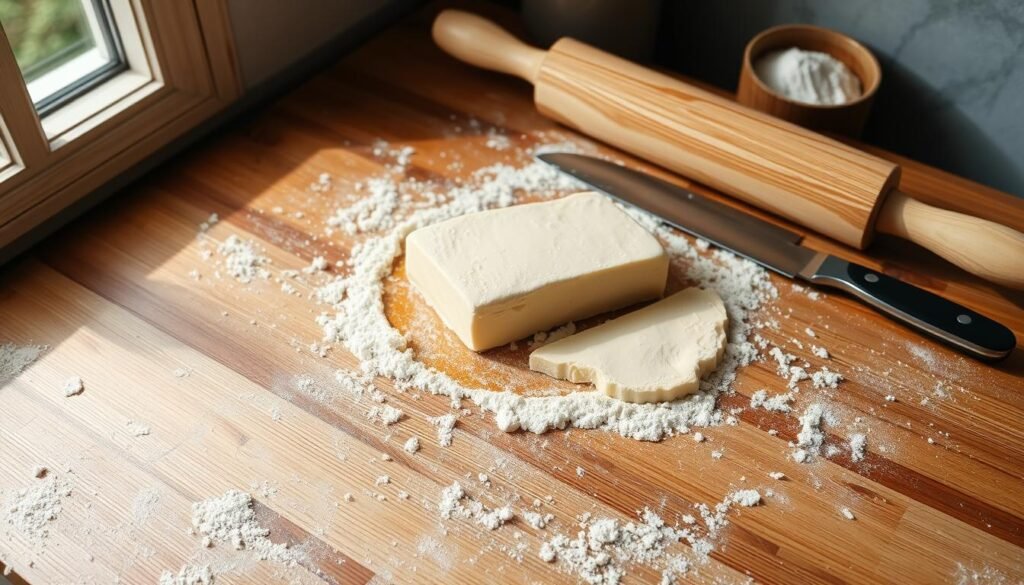
Making perfect homemade 7 days croissant is like turning your kitchen into a French bakery. In this 7-day guide, you’ll learn how to make buttery, flaky pastries like the pros. Say goodbye to store-bought croissants and hello to your own French pastry masterpiece.
Picture this: pulling golden, crisp croissants from your oven. Each bite reveals layers of flaky goodness. This guide will show you how to do it, step by step. You’ll learn to make these delicious treats in your own kitchen.
Key Takeaways
- Learn professional croissant-making techniques in just 7 days
- Understand the science behind perfect lamination
- Create bakery-quality pastries from your home kitchen
- Master temperature and ingredient control
- Transform your baking skills with authentic French methods
Understanding the Art of French 7 Days Croissant Making
Making the perfect croissant is a mix of skill, science, and love. It’s about mastering the art of croissant lamination. This turns simple ingredients into a flaky, buttery delight.
The Science Behind Perfect Lamination
7 Days Croissant lamination is the magic that makes them light and airy. It involves folding butter into dough, creating layers that puff up when baked. The trick is to control the temperature and fold correctly.
- Create alternating layers of dough and butter
- Maintain consistent dough and butter temperature
- Use precise folding techniques
“Lamination is the heart and soul of a perfect croissant” – French Pastry Chefs
Essential 7 Days Croissant Tools and Equipment
Having the right tools is key to success. Professional bakers use special equipment for top-notch results.
- Marble pastry board for temperature control
- Precise rolling pin
- Sharp pastry wheel
- Digital kitchen scale
Quality 7 Days Croissant Ingredients Matter
Not all ingredients are the same. Choosing high-quality ones can make a big difference. Use premium European butter and strong bread flour for better croissants.
| Ingredient | Quality Impact |
|---|---|
| European Butter | Creates flakier layers |
| Bread Flour | Provides better structure |
| Fresh Yeast | Ensures proper rising |
Remember, great croissants are about precision, patience, and passion!
Master Schedule: 7 Days Croissant Journey
Making the perfect croissant is an art that needs patience and precision. Your croissant schedule covers a 7 Days Croissant baking process. It turns simple ingredients into flaky, golden masterpieces. Each day builds on the last, creating a perfect mix of flavor and texture.
Your 7 day croissant baking journey includes several key stages. Each stage requires careful attention to detail:
- Day 1: Dough preparation and initial fermentation
- Day 2: Butter block creation
- Day 3: First lamination techniques
- Day 4: Advanced folding methods
- Day 5: Precise cutting and shaping
- Day 6: Proofing your croissants
- Day 7: Final baking and presentation
The croissant schedule is more than a timeline. It’s a detailed approach for professional-quality results. Precision matters more than speed in this delicate process.
“Perfection is not about doing extraordinary things, but doing ordinary things with exceptional care.” – Unknown Pastry Chef
| Day | Primary Focus | Key Action |
|---|---|---|
| 1 | Dough Development | Yeast activation, initial mixing |
| 2 | Butter Preparation | Creating uniform butter block |
| 3-4 | Lamination | Multiple fold techniques |
| 5 | Shaping | Precise cutting, rolling |
| 6 | Proofing | Controlled rising |
| 7 | Baking | Golden brown perfection |
The 7 day baking process turns raw ingredients into culinary art. Your patience and dedication will be rewarded with extraordinary croissants. They will rival those from professional bakeries.
Day One: Creating the Perfect Dough Base
Making great croissants starts with the dough. It’s all about understanding how to prepare it right.
Professional bakers say the key to amazing croissants is in the dough. Your first day will cover three important steps to make the dough.
Proper Yeast Activation
Yeast activation is a delicate process. It’s what gives your croissants their flavor and texture. Here’s how to do it right:
- Use fresh, high-quality active dry yeast
- Warm water to precisely 100-110°F
- Add a pinch of sugar to feed the yeast
- Allow 5-10 minutes for complete activation
Dough Temperature Control
Keeping the dough at the right temperature is key. You want it between 75-80°F during the first mix.
| Temperature Range | Impact on Dough |
|---|---|
| Below 70°F | Slow yeast activity |
| 75-80°F | Optimal yeast development |
| Above 85°F | Risk of over-fermentation |
Initial Fermentation Process
The first fermentation turns your ingredients into a tasty base. Patience is key during this stage. Let your dough rest and develop for about 1-2 hours at room temperature.
“Great croissants are not made in minutes, but through careful cultivation of flavor and texture.” – Master Baker François Laurent
By focusing on yeast activation, temperature, and fermentation, you’ll lay a strong foundation for your croissants.
Day Two: Butter Block Preparation and First Fold

Making the perfect butter block is key in croissant-making. It’s the heart of the lamination process, affecting the pastry’s flakiness and texture. Professional bakers say the butter’s consistency is vital for a great croissant.
To make your butter block, use high-quality, cold European-style butter. It should be firm but soft enough to shape like play-doh. You aim for a rectangular block that fits perfectly with your dough.
“The secret to a perfect croissant lies in the precise manipulation of butter and dough.” – Professional Pastry Chef
- Choose unsalted butter with high butterfat content
- Ensure butter is cold but malleable
- Use a rolling pin to shape your butter block
- Aim for a 7×7 inch square, about 1/2 inch thick
The first fold is critical in the croissant-making process. After making your butter block, you’ll wrap it in dough. This fold starts the creation of the flaky layers that croissants are famous for.
Being precise is important at this stage. The butter block and dough must be at the right temperature for lamination. If it’s too warm, the butter will melt; too cold, it won’t mix well.
Day Three: Mastering the Lamination Process
Croissant lamination is a magical process that turns simple dough into flaky, buttery layers. On day three, you’ll learn the key techniques that make croissants special. These techniques are what set amateur bakers apart from pros.
For successful lamination, you need precision, patience, and to know the double-turn and single-turn methods. Each method affects the texture and look of your croissants.
Double-Turn Technique
The double-turn technique makes your croissant dough incredibly delicate. Here’s how to get it right:
- Roll the dough into a rectangular shape
- Apply the butter block evenly
- Fold the dough in thirds, like a business letter
- Rotate 90 degrees and repeat the folding process
Single-Turn Method
The single-turn method is a bit simpler but also impressive. The main steps are:
- Spread butter across two-thirds of the dough
- Fold the unbuttered third over the buttered section
- Fold the remaining third on top
Resting Periods Between Folds
Rest is key in croissant lamination. Cold resting lets gluten relax and keeps butter from melting. Chill your dough for 30-60 minutes between turns to keep it in shape.
“Patience is the secret ingredient in perfect croissant lamination.” – Professional Pastry Chef
Temperature control is vital. Keep your dough and butter at 55-60°F for the best lamination.
Day Four: Final Folds and Shape Development
On day four, you’ll focus on the final folds and shaping of your croissants. This stage is key to turning your dough into a true French pastry.
The final folds are what make croissants so special. You aim to create layers that are both flaky and delicate. These layers will give your croissants their crisp outside and soft inside.
- Carefully roll out your chilled dough to a consistent thickness
- Maintain cold dough temperature during croissant shaping
- Use gentle, deliberate movements to preserve butter layers
“Precision in folding is the secret to a perfect croissant.” – French Pastry Chef
As you do the final folds, your dough will start to take shape. This process needs patience and a light touch. Each fold adds more layers, making the inside of your croissant look like a honeycomb.
Key Croissant Shaping Techniques
| Technique | Purpose | Key Tip |
|---|---|---|
| Tri-fold method | Creates multiple butter layers | Keep dough cold |
| Edge trimming | Ensures clean, even layers | Use sharp pastry wheel |
| Resting periods | Relaxes gluten structure | Refrigerate between folds |
Pro tip: Your dough’s temperature is key during the final folds. If it’s too warm, the butter will mix in too much. If it’s too cold, it might crack.
Day Five: Cutting and Shaping Techniques
Learning to cut and shape croissants makes your baking look and taste like a pro’s. This step is key to your pastries’ look and feel. You need to be precise with laminated dough.
Professional bakers know cutting croissants needs special skills and measurements. You aim to make pastries that are both beautiful and delicious.
Classic Croissant Measurements
To make croissants like a bakery, knowing exact measurements is important. Here are the classic sizes:
- Length: 6-8 inches
- Width at base: 2-3 inches
- Height when proofed: 1-1.5 inches
- Weight: 2-3 ounces
Rolling and Forming Methods
Shaping croissants takes patience and practice. Begin by rolling the dough into a large triangle. Make sure it’s even all the way through.
- Use a sharp pastry wheel for clean cuts
- Stretch the dough gently during rolling
- Create slight tension when forming the shape
- Tuck the tip underneath for a classic curve
“The secret to perfect croissants lies in the delicate balance between technique and touch.” – Master Baker Jean Pierre
Your cutting method greatly affects your croissants’ look and feel. Take your time and aim for consistency.
| Technique | Key Considerations | Difficulty Level |
|---|---|---|
| Triangle Cutting | Precise angle measurements | Intermediate |
| Classic Rolling | Even pressure and gentle stretching | Advanced |
| Shape Forming | Consistent curve and tip placement | Expert |
Keep practicing these techniques to improve your baking. Soon, you’ll make pastries that look like they came from a bakery.
Day Six: Proofing Your Croissant

Croissant proofing is the magic that turns dough into light, airy pastries. This stage is key for the final texture and rise of your croissants. Mastering proofing can make your baking truly special.
“Perfect proofing is like conducting a delicate symphony of temperature, humidity, and time.” – Professional Baker’s Secret
Your proofing area needs to be just right. Look for a warm, draft-free spot with 75-80°F temperatures and 70-75% humidity. These conditions help yeast work its magic, creating flaky layers.
- Use a proofing box or create a warm area in your kitchen
- Cover croissants with a damp cloth to prevent surface drying
- Check proofing progress every 30-45 minutes
To see if your croissants are ready, look for these signs:
- Doubled in size
- Soft and puffy texture
- Gentle indentation that slowly springs back when touched
Pro tip: Overproofing can ruin your layers, so watch your croissants closely during this important stage.
Day Seven: Baking for Professional Results
The last day of making croissants is all about turning your dough into perfect pastries. Baking croissants needs precision to get that golden-brown crust. This crust will make your mouth water.
Temperature and Timing Guidelines
Getting the oven temperature right is key for great croissants. Professional bakers suggest:
- Preheat your oven to 400°F (204°C)
- Place croissants on a parchment-lined baking sheet
- Ensure adequate spacing between pastries for even baking
Achieving Golden-Brown Perfection
Two techniques are essential for a stunning golden-brown crust:
- Egg Wash: Apply a light egg wash before baking to enhance color and shine
- Precise Baking Time: Bake for 15-18 minutes until edges are deeply caramelized
“A perfectly baked croissant should have a crisp exterior and a soft, airy interior.” – Professional Pastry Chef
Keep an eye on your croissants in the last minutes of baking. The line between golden-brown and burnt is thin. Take them out when they’re a rich, amber color with flaky, buttery layers.
Troubleshooting Common 7 Days Croissant Problems
Croissant baking can be tricky for home bakers. Knowing the usual problems helps make flaky pastries every time. Let’s look at common issues and how to fix them.
Many challenges can happen when baking croissants. Spotting these problems early can save your pastry. It ensures a top-quality result.
- Butter Leakage: This happens when butter gets out during baking, making a mess
- Uneven Rising: Stops the croissants from getting their signature layers and height
- Lack of Flakiness: Makes the croissants dense, like bread, instead of light and crisp
Here are some ways to fix these common problems:
| Problem | Cause | Solution |
|---|---|---|
| Butter Leakage | Warm kitchen temperature | Chill dough between folds, keep work surface cool |
| Uneven Rising | Incorrect yeast activation | Use fresh yeast, proof at consistent temperature |
| Dense Texture | Overworking dough | Handle dough little, use precise lamination |
“Patience and precision are the secrets to perfect croissants.” – Professional Baker’s Wisdom
With these tips, you can solve common baking problems. This way, you can make bakery-quality croissants at home.
Conclusion
Your 7-day journey in French pastry skills has changed you. You’re now a confident croissant maker. You’ve learned about lamination, temperature control, and patience.
These skills will help you make amazing homemade croissants. They’re as good as those from a professional bakery.
Every day of this journey has helped you understand croissant making better. You’ve learned how to make the perfect dough and master folding techniques.
These skills are more than just a recipe. They let you try new things and grow as a baker.
Remember, getting better at French pastry takes time and practice. Your first batch might not look perfect, but that’s okay.
With each try, you get closer to making those delicious, flaky layers. Keep learning, document your progress, and feel free to try new things.
As you get better at making croissants, try other French pastries like pain au chocolat or brioche. Your hard work and new skills will open up a world of tasty possibilities in your kitchen.
FAQ
How difficult is it to make croissants at home?
Making croissants at home takes patience and practice. Our 7-day guide makes it easier. With the right technique and ingredients, you can make delicious croissants at home.
What special equipment do I need to make croissants?
You’ll need a digital kitchen scale, rolling pin, and baking sheets. Parchment paper and a bench scraper are also essential. A stand mixer helps but isn’t necessary.
Why does the butter block and lamination process seem so complicated?
The lamination process is key for flaky layers in croissants. It might seem hard at first. But our guide will help you understand and master it.
Can I freeze croissant dough for later use?
Yes, you can freeze croissant dough at different stages. Freeze unproofed croissants for up to two weeks. Then, thaw them in the fridge overnight and bake as usual.
What type of butter works best for croissants?
Use high-fat European-style butter with 82-85% butterfat. This butter has less water and better flavor and texture than American butter.
How can I tell if my croissant are properly proofed?
Properly proofed croissants are puffy and 50-75% bigger. They should spring back when pressed gently. The dough should feel light and airy, not dense.
Why do my croissant leak butter during baking?
Leaking butter happens when dough is too warm or butter block isn’t right. Keep dough cold, use precise folding, and ensure butter is correct consistency to avoid leaks.
How long do homemade croissants stay fresh?
Enjoy homemade croissant within 24 hours. Store them in a paper bag at room temperature. Freeze fully baked croissants for up to two weeks. Reheat frozen croissants in a 300°F oven for 5-7 minutes.
Can I make variations of the classic croissant?
Yes! Once you learn the basic technique, try chocolate-filled, almond, or savory croissants. The lamination process remains the same.
What’s the most common mistake when making croissants?
The biggest mistake is not controlling temperature. Keep butter and dough cold for perfect layers and flaky texture.
RELATED POSTS
For more breakfast inspiration, check out these delicious recipes on our site:
